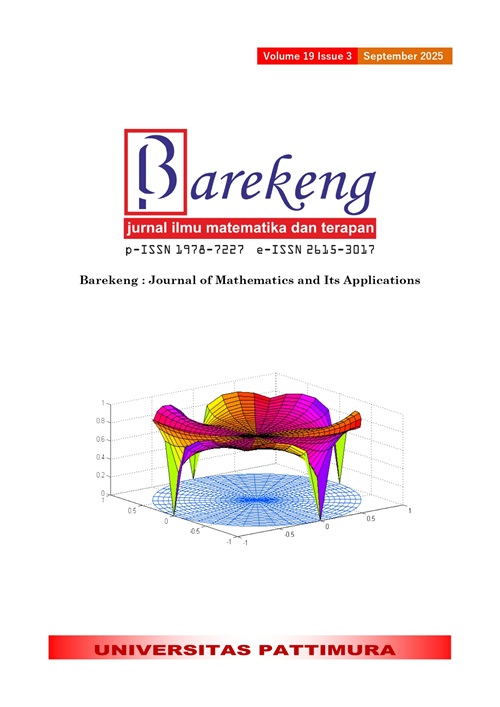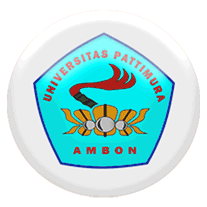SURVIVAL ANALYSIS ON DATA OF STUDENTS NOT GRADUATING ON TIME USING WEIBULL REGRESSION, COX PROPORTIONAL HAZARDS REGRESSION, AND RANDOM SURVIVAL FOREST METHODS
Abstract
This article presents a comprehensive study of the factors that influence the length of study data of undergraduate students at FMIPA UNIB class 2018 and 2019. This study is essential because observations show that many students study for more than 8 semesters. The purpose of this study is to determine the factors that significantly influence the length of study of undergraduate students. These factors can be internal and external. Survival analysis is the right method to identify these factors because ordinary regression analysis is unable to estimate survival data. Therefore, methods such as Weibull regression, Cox Proportional Hazards regression, and Random Survival Forest are used. This study does not compare the methods used because these methods are independent of each other, but have the same goal, namely, to determine the factors that influence the length of study of students. The data used in this study are data on the length of study of students from the 2018 and 2019 cohorts sourced from the academic subsection of FMIPA UNIB, with variables of GPA, gender, region of origin, university entry route, parents' occupation, type of study program, and length of study. The results showed that GPA and the type of study program significantly influenced the length of study in Weibull regression analysis. In Cox proportional hazard regression, the GPA variable is an influential factor, while using the Random Survival Forest method, all factors significantly influenced the length of study, with their respective levels of importance.
Downloads
References
R. Widyastuti, D. Wulandari, and D. Prasetyowati, “PENERAPAN REGRESI COX UNTUK MENGANALISIS VARIABEL YANG BERPENGARUH TERHADAP DURASI STUDI MAHASISWA,” vol. 13, pp. 88–98, 2024. doi: https://doi.org/10.14710/j.gauss.13.1.88-98
E. T. Lee and J. W. Wang, STATISTICAL METHODS FOR SURVIVAL DATA ANALYSIS, Third Edit. A John Wiley & Sons, INC., Publication, 2015.
U. L. Mangkurat, “ANALISIS REGRESI COX UNTUK MENENTUKAN FAKTOR-FAKTOR YANG MEMPENGARUHI LAMA STUDI MAHASISWA S1 FMIPA UNIVERSITAS LAMBUNG MANGKURAT 1,2,3,” vol. 13, pp. 1–12, 2024. doi: https://doi.org/10.14710/j.gauss.13.1.1-12
M. A. Alwansyah, “SURVIVAL ANALYSIS OF STUDENTS NOT GRADUATED ON TIME USING COX PROPORTIONAL HAZARD REGRESSION METHOD AND RANDOM SURVIVAL FOREST METHOD,” J. Stat. Data Sci., vol. 2, no. 1, pp. 13–21, 2023. doi: https://doi.org/10.33369/jsds.v2i1.24312
D. A. I. Maruddani, Tarno, A. Hoyyi, R. Rahmawati, and Y. Wilandari, SURVIVAL ANALYSIS. UNDIP Press Semarang, 2021.
J. P. Klein and M. L. Moeschberger, SURVIVAL ANALYSIS TECHNIQUES FOR CENSORED AND TRUNCATED DATA SECOND EDITION, vol. 19, no. 5. John Wiley. New Jersey., 2003. doi: https://doi.org/10.1007/b97377
Roger Koenker, V. Chernozhukov, X. He, and L. Peng, HANDBOOK OF QUANTILE REGRESSION, First Edit. CRC Press Taylor & Francis Group, 2018. doi: https://doi.org/10.1201/9781315120256
D. C. Montgomery, E. A. Peck, and G. G. Vining, INTRODUCTION TO LINEAR REGRESSION ANALYSIS, Sixth Edit. Wiley Series in Probability And Statistics, 2021.
M. Sriningsih, D. Hatidja, and J. D. Prang, “PENANGANAN MULTIKOLINEARITAS DENGAN MENGGUNAKAN ANALISIS REGRESI KOMPONEN UTAMA PADA KASUS IMPOR BERAS DI PROVINSI SULUt,” J. Ilm. Sains, vol. 18, no. 1, p. 18, 2018. doi: https://doi.org/10.35799/jis.18.1.2018.19396
C. Kartsonaki, “SURVIVAL ANALYSIS,” Diagnostic Histopathol., vol. 22, no. 7, pp. 263–270, 2016. doi: https://doi.org/10.1016/j.mpdhp.2016.06.005
D. F. Moore, APPLIED SURVIVAL ANALYSIS USING R. New York:Springer, 2016. doi: https://doi.org/10.1007/978-3-319-31245-3
N. Eliyati, S. I. Maiyanti, O. Dwipurwani, and S. W. Hamidah, “Model Regresi Cox Untuk Menganalisis Pengaruh Faktor Asupan Makanan Terhadap Risiko Kekambuhan Endometriosis,” BAREKENG J. Ilmu Mat. dan Terap., vol. 15, no. 1, pp. 103–114, 2021. doi: https://doi.org/10.30598/barekengvol15iss1pp103-114
D. Collet, MODELLING SURVIVAL DATA IN MEDICAL RESEARCH, Fourth edi. CRC texts in statistical science, 2023.
K. L. Pickett, K. Suresh, K. R. Campbell, S. Davis, and E. Juarez-Colunga, “RANDOM SURVIVAL FORESTS FOR DYNAMIC PREDICTIONS OF A TIME-TO-EVENT OUTCOME USING A LONGITUDINAL BIOMARKER,” BMC Med. Res. Methodol., vol. 21, no. 1, pp. 1–14, 2021. doi: https://doi.org/10.1186/s12874-021-01375-x
M. Rezaei, L. Tapak, M. Alimohammadian, A. Sadjadi, and M. Yaseri, “JOURNAL OF BIOSTATISTICS AND EPIDEMIOLOGY,” J Biostat Epidemiol., vol. 1, no. Iran, pp. 37–44, 2020.
S. Nurhaliza, K. Sadik, and A. Saefuddin, “A COMPARISON OF COX PROPORTIONAL HAZARD AND RANDOM SURVIVAL FOREST MODELS IN PREDICTING CHURN OF THE TELECOMMUNICATION INDUSTRY CUSTOMER,” BAREKENG J. Ilmu Mat. dan Terap., vol. 16, no. 4, pp. 1433–1440, 2022. doi: https://doi.org/10.30598/barekengvol16iss4pp1433-1440
M. Mohammed, I. B. Mboya, H. Mwambi, M. K. Elbashir, and B. Omolo, “PREDICTORS OF COLORECTAL CANCER SURVIVAL USING COX REGRESSION AND RANDOM SURVIVAL FORESTS MODELS BASED ON GENE EXPRESSION DATA,” PLoS One, vol. 16, no. 12 December, pp. 1–22, 2021. doi: https://doi.org/10.1371/journal.pone.0261625
B. M. Iskandar, “MODEL COX PROPORTIONAL HAZARD PADA KEJADIAN BERSAMA,” Universitas Negeri Yogyakarta, 2015.
Copyright (c) 2025 Ramya Rachmawati, Nur Afandi, Muhammad Arib Alwansyah

This work is licensed under a Creative Commons Attribution-ShareAlike 4.0 International License.
Authors who publish with this Journal agree to the following terms:
- Author retain copyright and grant the journal right of first publication with the work simultaneously licensed under a creative commons attribution license that allow others to share the work within an acknowledgement of the work’s authorship and initial publication of this journal.
- Authors are able to enter into separate, additional contractual arrangement for the non-exclusive distribution of the journal’s published version of the work (e.g. acknowledgement of its initial publication in this journal).
- Authors are permitted and encouraged to post their work online (e.g. in institutional repositories or on their websites) prior to and during the submission process, as it can lead to productive exchanges, as well as earlier and greater citation of published works.






1.gif)



